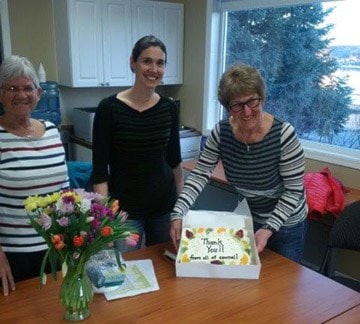CNC Youth Centre in transition
The College of New Caledonia is looking for regional partners to continue its youth centre in Vanderhoof.
Presenting to the district council on March 14, Scott Zayac, CNC’s regional principal of Lakes/Nechako, said the college will withdraw its support of family support services in the region by July, as part of its restructuring process this year.
Started in 2011 as part of its literacy project, the program has been successful in providing an inclusive space for youth aged 13 to 18, said support worker Annerose Georgeson.
With a strict drug-free policy and providing snacks, Internet, job postings, as well workshops, the centre welcomes up to 30 youth a day, and was visited by B.C.’s Lieutenant-Governor last year.
CNC’s aboriginal support worker Reg Mueller says the centre provides opportunities for one-on-one counselling for kids seeking safety or guidance outside of home.
District staff now works with CNC and its current partners to look at funding opportunities to continue the program.
The youth centre budget for 2015-16 totals $94,240 — $30,000 of which is contributed by the District of Vanderhoof in facility costs.
Mayor Gerry Thiessen says it’s a philosophical change.
“It’s sad for the College of New Caledonia to not do those programs,” he said. “This is something that’s needed in our community, a place that they can go to and hang out.”
Pool design committee established
The Vanderhoof Aquatic Centre design committee is now comprised of:
Three district councillors - Steve Little, Ken Young, Brian Frenkel
Three community members - Zoe Dhillon (chemical engineer), Steve Johnson (project manager), and Keith Prattke (retired engineer)
The committee will be meeting with Bruce Carscadden Architects Inc. and gathering public input for the next six months to prepare a tender-ready design.
The meetings are open to the public, and notice will be sent out once the first meeting date is scheduled.
Airport access upgrade
The District of Vanderhoof is applying to the British Columbia Air Access Program for a navigation upgrade for its airport.
The enhanced GPS, called the Wide Area Augmentation System, would enable Lateral Procedure with Vertical Guidance (LPV), lowering the current plane approach limit from 512 feet to 250 feet.
A lower height limit allows more planes to land in varying weather conditions, and LPV also reduces chances of accidents when planes approach and land.
Helping planes to overcome bad weather and non-ideal runway conditions, the new system “is not just an upgrade, but an update,” said Royce Chaff from the Vanderhoof Flying Club.
Mayor Gerry Thiessen says the upgrade would not only ensure ambulance planes have access, but also support the opportunities for mining exploration in the area.
Ice allocation
A youth-focused ice allocation policy for Vanderhoof’s arena has been adopted on March 14.
The motion to establish procedures in writing was passed last August, as growing clubs led to conflicts in scheduling ice times.
The District of Vanderhoof Ice Allocation Policy can be found on the district’s website on www.vanderhoof.ca
Waste to energy municipal model test
An environmental professional looks to use Vanderhoof’s waste to test a waste-to-energy model targeted to small communities.
In a presentation to the district council on March 14, Geoffrey Mercer explains the process of hydrothermal liquefaction that uses high temperature and pressure to turn organic waste into bio-crude and bio-gas. The products can then be refined and used as fuel to generate electricity and heat.
Requesting $65,000 from the District of Vanderhoof, Mercer looks to conduct an initial feasibility study in conjunction with the University of Northern British Columbia, as well as construct a demonstration model that would pump Vanderhoof’s sewage through a continuous coil, compressing and refining it on-site.
He says while current research revolves around large corporations with batch productions, and northern European countries currently use a similar process, his model will explore the efficiency of the process for small communities.
“The most exciting aspect of both biogas and biofuel is that they may be produced from numerous sources of organic material, many of which have a negative associated cost,” Mercer said. “Organic waste from municipal waste streams and wastewater treatment facilities have a cost of handling associated with them and may be available for a fraction of the cost of crop residue and wood waste.
“The process of creating and burning both biofuel and biogas is carbon neutral as the carbon is already present in the carbon cycle and any carbon released from these materials was originally captured from the atmosphere.”
A community member at council meeting raised the concern of whether the district will have adequate supply from only one source of organic waste. A mixed stream — including animal waste, crop residue, and wood products — is feasible, though a pure source of organic feedstock may be more efficient, Mercer explained.
Mayor Gerry Thiessen says that though it’s an exciting project, more analysis will be necessary before commitment from the district.
“To me, the people of Vanderhoof would love to be a test case for getting rid of waste, to be turned into energy,” Thiessen said. “As a community, we have to be sure it’s a proven example for a $65,000 demonstration project.
“We look forward to hearing from him in the future.”
- with files from the district of Vanderhoof
